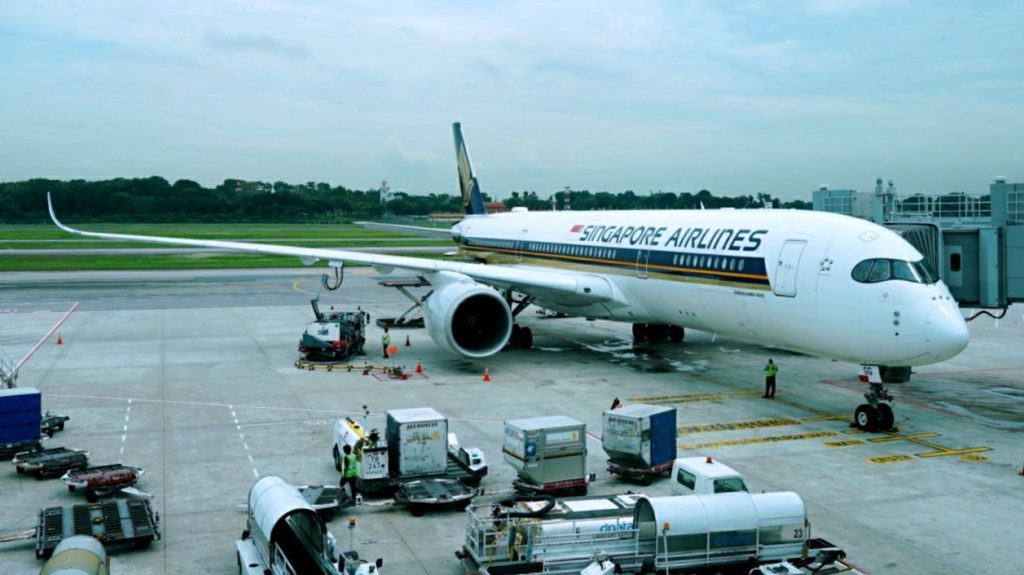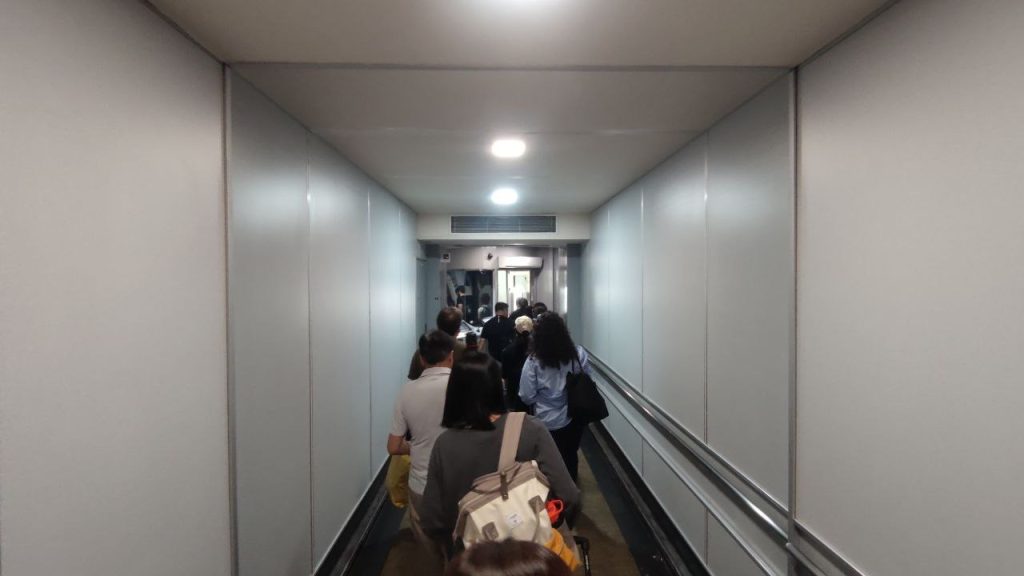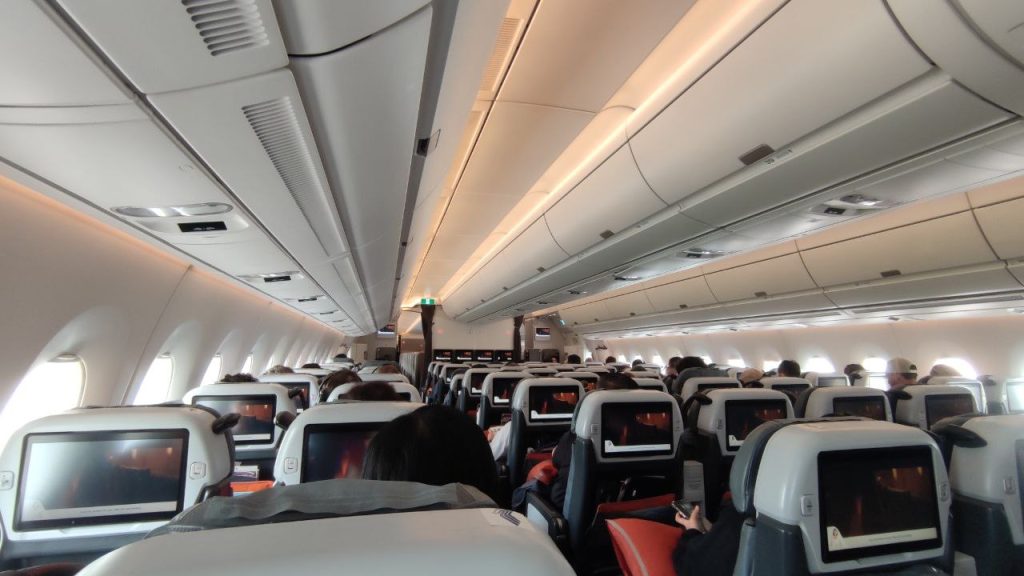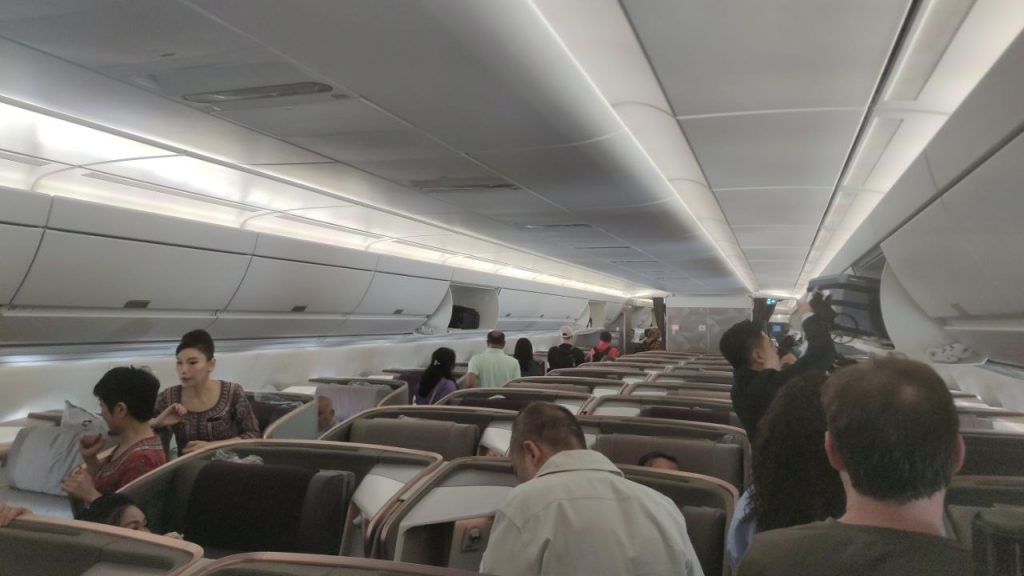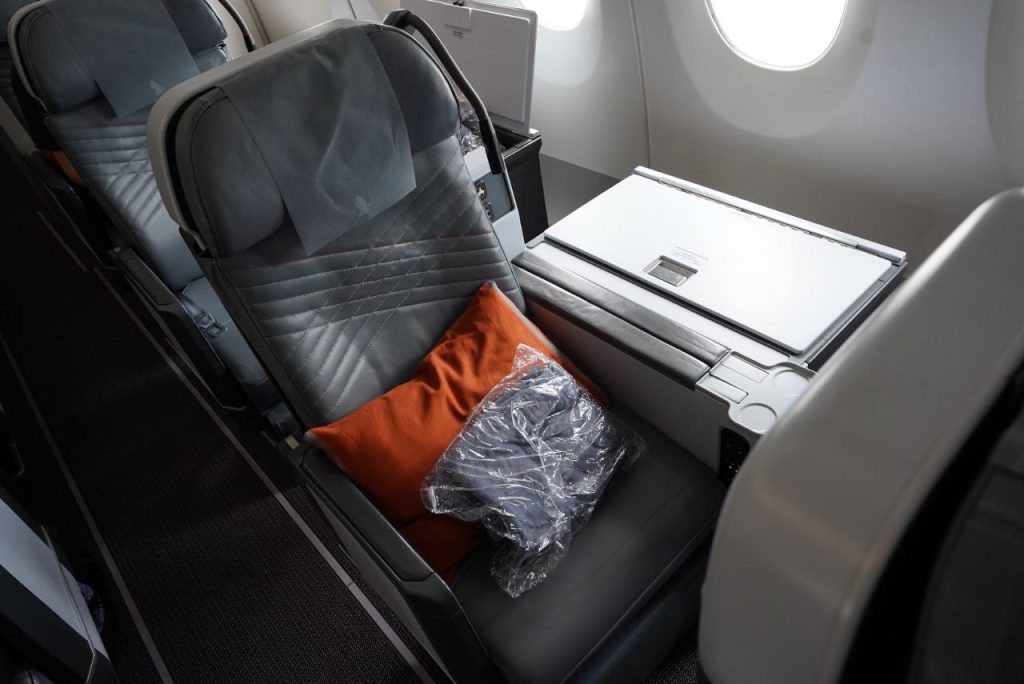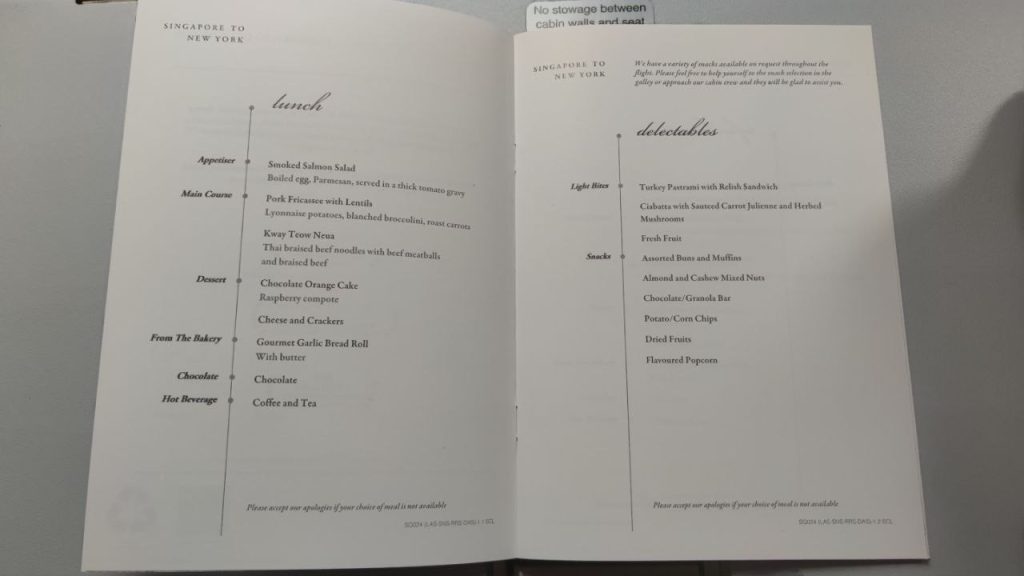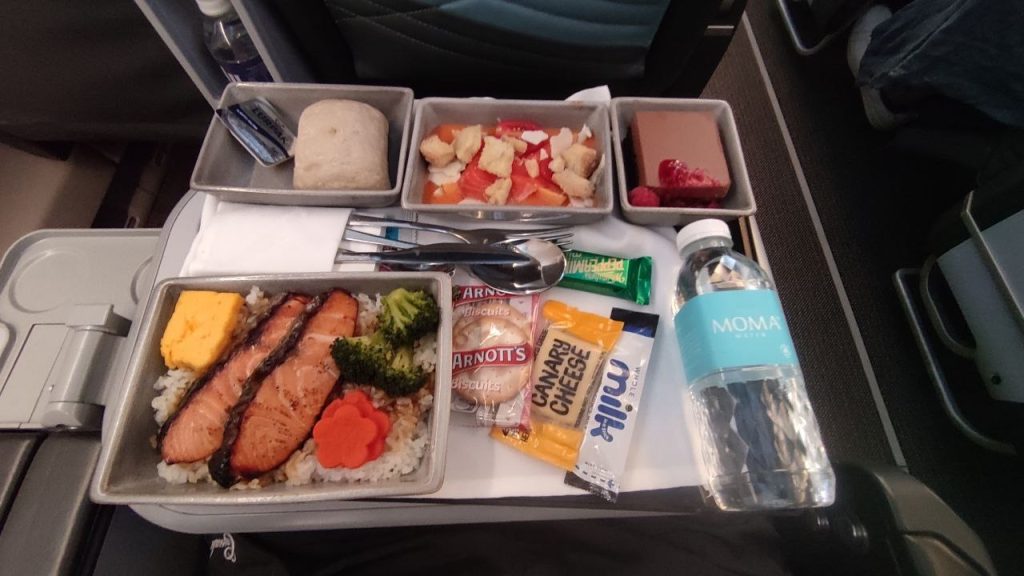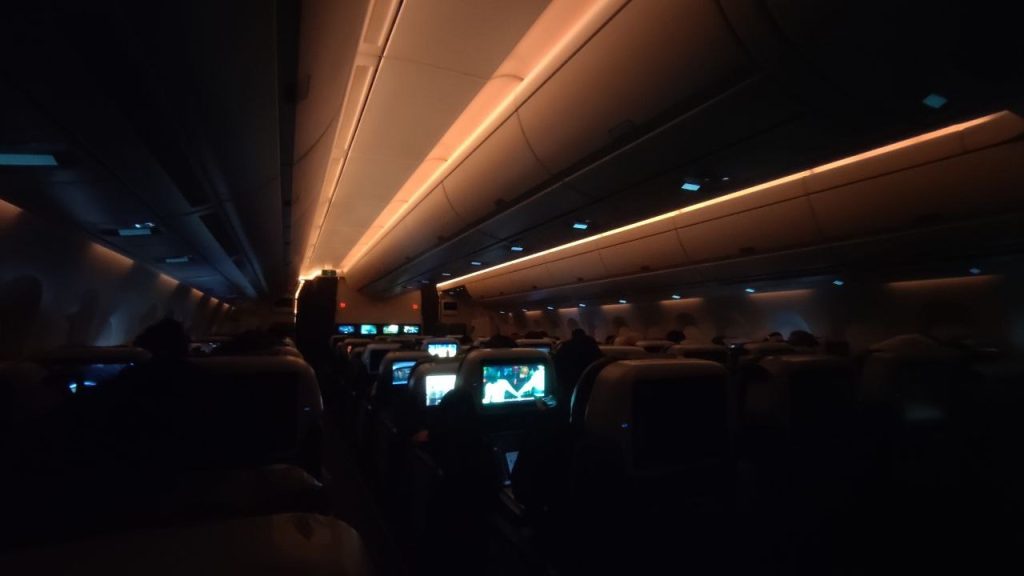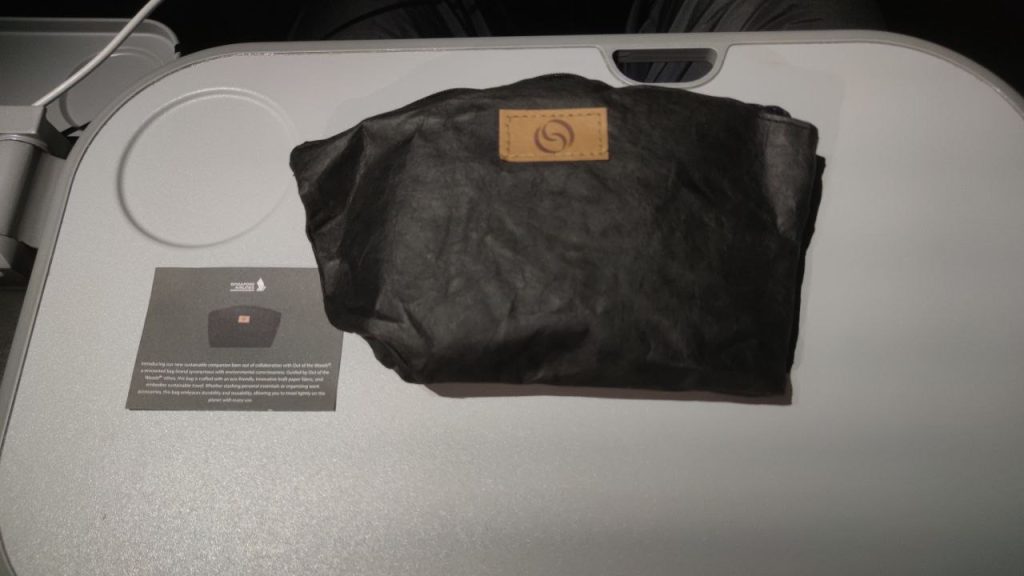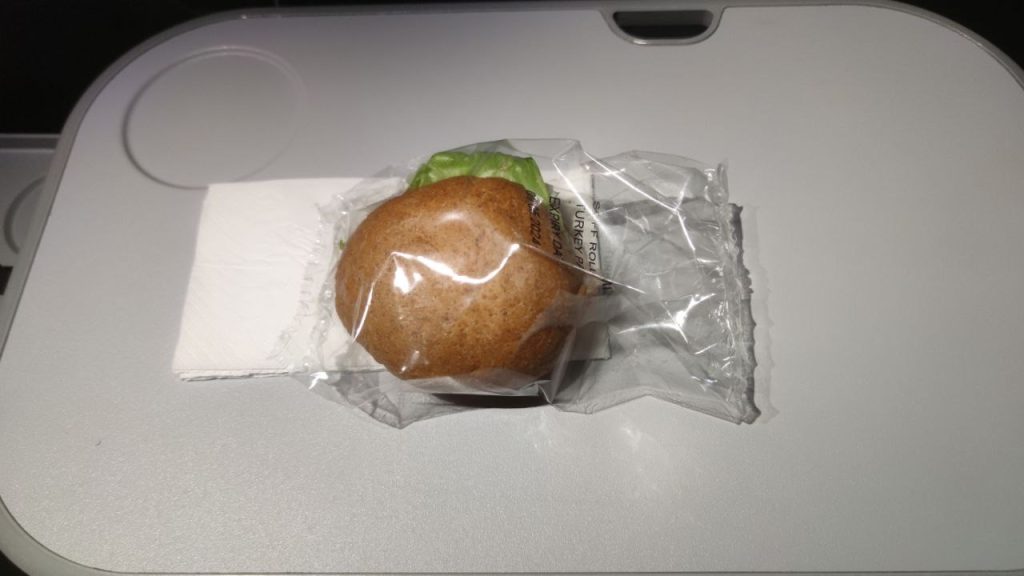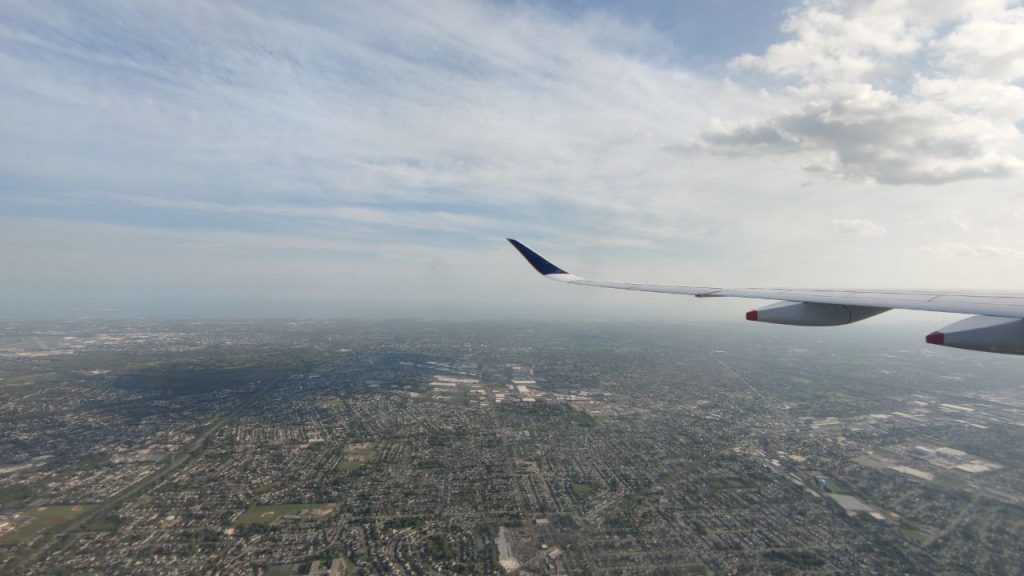Airlines
Behind the Letters: The Naming System of American Military Aircraft

In the dynamic world of aviation, a diverse array of aircraft has taken to the skies. A noticeable pattern appears among them: a considerable number of American fighter jets start their names with the letter “F.” However, this convention is not universal, as the U.S. Department of Defense (DoD) meticulously regulates the nomenclature of aircraft. This system, designed to classify and name aircraft, extends its influence to the nomenclature of American fighter jets.
India designates SpiceJet as scheduled carrier to United States(Opens in a new browser tab)
- F: This letter designates “Fighter.” Fighter aircraft are designed primarily for air-to-air combat and have the capability to engage other aircraft.
- A: This letter designates “Attack.” Attack aircraft are primarily used for ground attack missions, including close air support for ground troops.
- B: This letter designates “Bomber.” Bomber aircraft are designed for strategic or tactical bombing missions.
- C: This letter designates “Cargo.” Cargo aircraft are used for transporting goods, equipment, and personnel.
- E: This letter designates “Electronic.” Electronic warfare aircraft are equipped with systems for electronic countermeasures and signals intelligence.
- H: This letter designates “Helicopter.” Helicopters are rotary-wing aircraft used for a variety of purposes, including transport, reconnaissance, and combat support.
- K: This letter designates “Tanker.” Tanker aircraft are used for aerial refueling of other aircraft.
- M: This letter designates “Multi-mission.” This category is a bit more flexible and can encompass aircraft with multiple roles, such as the V-22 Osprey, which combines elements of helicopters and fixed-wing aircraft.
- R: This letter designates “Reconnaissance.” Reconnaissance aircraft are used for intelligence gathering and surveillance missions.
- S: This letter designates “Anti-Submarine Warfare.” These aircraft are used for submarine detection and warfare.
- T: This letter designates “Trainer.” Trainer aircraft are used for pilot training.
- U: This letter designates “Utility.” Utility aircraft serve a variety of non-combat roles, such as medical evacuation or general support.
1.Fighter jets are classified as “F” aircraft, owing to their principal purpose in air-to-air combat. The “F” designation is usually followed by a numerical sequence denoting the order in which the aircraft was developed or introduced. The F-15 Eagle, F-16 Fighting Falcon, F-22 Raptor, and F-35 Lightning II are just a few examples. These numerical identifiers make differentiating between fighter jet models simple.
2.Attack aircraft, also known as ground-attack aircraft or strike aircraft, are identified with the letter “A” to indicate that their primary mission is to engage targets on the ground, such as enemy installations, armoured vehicles, and other ground-based threats. A-10 Thunderbolt II (“Warthog”), A-6 Intruder, and A-7 Corsair II are just a few Examples.
What is the Boeing P-8I in the Indian Navy used for?(Opens in a new browser tab)
3.Bomber aircraft, on the other hand, fall into the “B” category, indicating that their major purpose is in strategic or tactical bombing missions. The “B” designation, like those of fighter jets, is followed by a numerical sequence that denotes the aircraft’s order of development or launch. These designations aid in distinguishing between various bomber models. Here are some notable bomber aircraft examples: Such are the B-17 Flying Fortress, the B-52 Stratofortress, and the B-1 Lancer.
4.Cargo planes, which transport products and equipment, utilize a similar alphanumeric naming system to aid distinguish between models. Cargo aircraft names are primarily based on the manufacturer’s system, and while they may not be as standardized as fighter jet designations, they still provide significant information about the aircraft’s mission, capacity, and generation. Cargo airplanes are frequently designated with a “C” (for Cargo) followed by a numeral sequence. Here are some notable examples: C-130 Hercules, C-17 Globemaster III, and C-5 Galaxy.
5.Electronic warfare aircraft are specialised planes outfitted with electronic countermeasures and signals intelligence gear. These aircraft are vital in modern warfare because they disrupt enemy communications, radar, and other electronic equipment, as well as acquire intelligence through electromagnetic waves. These aircraft are frequently identified by letters such as “E” (for Electronic Warfare) followed by a numerical series.A few examples include the EA-6B Prowler, EA-18G Growler, and EC-130H Compass Call.
6.Helicopters are rotary-wing aircraft that can be employed for transport, reconnaissance, and combat support. Helicopter designations frequently feature a “H” followed by a numerical sequence indicating the order of development or debut of the helicopter model. This approach aids in distinguishing between various helicopter types and their tasks. Here are some examples of helicopters such as H-60 Black Hawk Series, H-64 Apache,H-1 Huey Series.
7.Tankers are specialized aircraft that refuel other aircraft in flight, extending their operational range and endurance. Tanker aircraft are frequently designated with the letter “K,” indicating their major duty in aerial refuelling. Here are some examples of tanker aircraft such as KC-135 Stratotanker, KC-10 Extender, and KC-130 Hercules.
8. This letter stands for “Multi-mission.” This category is more open and can include aircraft that serve various functions, such as the V-22 Osprey, which combines elements of helicopters and fixed-wing aircraft. Its ability to take off and land vertically like a helicopter and then transition to a forward flight mode like a fixed-wing aircraft makes it versatile for various missions.
Alaska Airlines introduces electronic bag tags(Opens in a new browser tab)
9. Reconnaissance aircraft, on the other hand, fall under the “R” category, indicating that its primary purpose is to conduct reconnaissance or intelligence-gathering missions. These numerical identifiers aid in identifying between different reconnaissance aircraft models. Here are some examples of reconnaissance aircraft: RQ-4 Global Hawk, RF-4 Phantom II.
10.Anti-Submarine Warfare (ASW) aircraft use a similar name scheme for simple identification and distinguishing. ASW aircraft are primarily built and outfitted to detect and engage submarines in the maritime environment. They are critical for naval operations and maintaining sea control, with prominent examples include the S-10 Seahawk, S-22 Stingray, and S-8 Manta.
11.Trainer aircraft are denoted by the letter “T” to indicate their major use in pilot training. These trainer planes are vital for training new pilots, letting them to learn the fundamentals of flying and developing various techniques before advancing to more complex and specialized planes. T-6 Texan II, T-38 Talon, and T-50 Golden Eagle are examples of notable trainer aircraft.
12.Utility aircraft are versatile aircraft that serve various non-combat roles, providing support and fulfilling essential functions in different sectors. These aircraft are designed to perform tasks that contribute to logistics, transportation, rescue operations, medical services, and other specialized missions. Some common examples for utility aircraft are UH-60 Black Hawk, AgustaWestland AW139, DHC-6 Twin Otter.

Airlines
Air India Flight Collides with Tug Tractor, at Pune Airport

An Air India flight bound for Delhi faced an unexpected hurdle during its taxi towards the runway at Pune Airport on Thursday, May 16th.
The aircraft, carrying 180 passengers, encountered a collision with a tug tractor, though fortunately, no injuries were reported among the passengers or crew. The incident, while causing significant damage to the aircraft, triggered swift emergency protocols, ensuring the safety of all individuals involved.
Upon the mishap, passengers were promptly disembarked from the plane, and alternative arrangements were made for their accommodation as they found themselves stranded at the airport. The Directorate General of Civil Aviation (DGCA) has initiated an inquiry to ascertain the cause of the collision, according to ANI reports.
Preliminary findings suggest that the tug truck, utilized for maneuvering the aircraft on the ground, inadvertently struck the plane during the taxiing process. Despite the incident, airport operations continued with minimal disruption. However, the affected aircraft was temporarily withdrawn from service for comprehensive inspection and necessary repairs.
Air India, in response to the situation, assured passengers of full refunds and complimentary rescheduling. The airline’s statement conveyed, “There was an incident related to one of our aircraft, which was to operate Pune to Delhi, at the time of its pushback. The aircraft was held back for checks, all passengers were offloaded safely, and the flight was cancelled.”
Passengers affected by the cancellation were provided with refunds and the option for rescheduling their travel plans without additional charges. The damage to the aircraft, primarily located near the belly where the pushback tug made contact, underscores the need for a thorough investigation into the circumstances surrounding the collision.
Airlines
After Flight Cancellation, Virgin Atlantic Passengers Told to Arrange Own Hotels
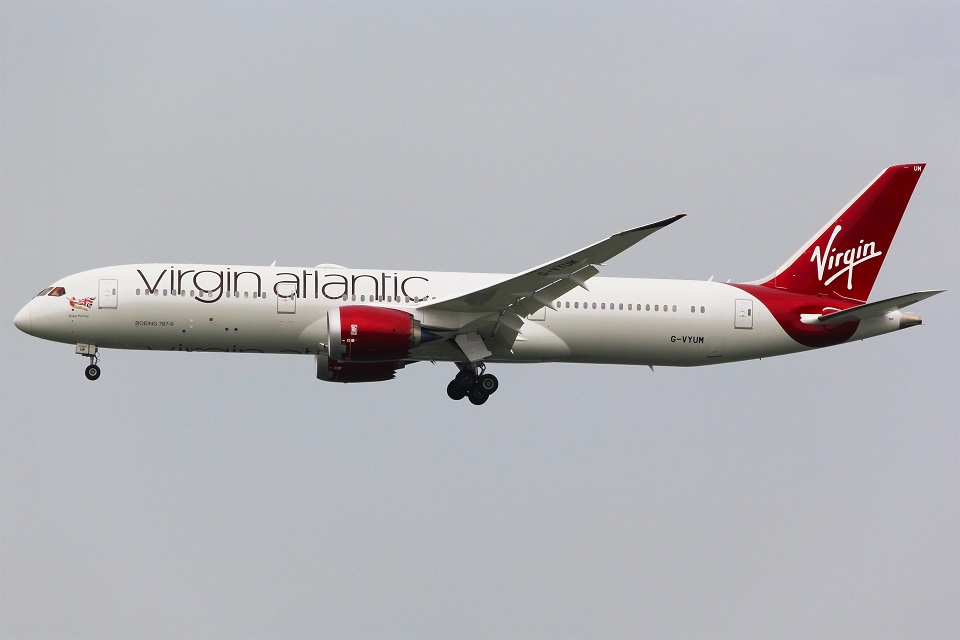
Ian Field and his partner Jane, both residents of the London area, faced an unexpected and costly ordeal while on a trip to St. Lucia in the Caribbean.
The couple, who had flown out from Heathrow on Virgin Atlantic flight VS221 on May 5, discovered upon arrival that their May 15 return flight was canceled for “operational reasons.” Despite Virgin Atlantic’s explanation, Field suspected the cancellation was due to a lack of passengers, as the airline is set to cease the route after May 19.
Stranded on the island, Field and Jane were left to fend for themselves for two additional nights. Both Virgin Atlantic and their travel agency, Blue Bay Travel, failed to provide assistance or accommodation, forcing the couple to pay over £400 out of pocket for their hotel stay.
Virgin Atlantic advised those without sufficient funds to seek financial help from family members, which added to the couple’s frustration. “We feel completely abandoned and let down terribly,” Field expressed to The Independent.
The lack of response from Virgin Atlantic and the unhelpful attitude of the travel agent exacerbated their distress. Although Field and his partner could afford the unexpected expense, he expressed concern for those who might not be in a similar financial position.
In response, a Virgin Atlantic spokesperson stated that all affected customers were rebooked on alternative flights and could amend their bookings through the airline’s “rebook me” function if needed. The spokesperson apologized for the delay and inconvenience, assuring that customers would receive EC261 compensation of £520 per person and be reimbursed for any out-of-pocket expenses incurred.
Airlines
Flight Review: World’s longest flight in Premium Economy

Welcome to a flight review on Singapore Airlines’ flagship Airbus A350-900ULR flight to New York’s John F Kennedy international airport. With a scheduled flight time of 18 Hours and 40 minutes, together with an average distance of 9,800 miles, this flight is so long that Singapore Airlines does not have a economy class cabin on it. This means that aircrafts which ply this route are specially configured, having only Premium Economy and Business class seats. This flight is also currently the world’s longest flight.
Check-in
I checked in at the mobile kiosk at Changi Airport Terminal 3. However, even though I was able to print out the baggage tags, I was not able to check-in my bags at the self check-in counter. Instead, I soon found out that travellers bound for the United States are supposed to proceed to the manual counters to check-in their baggage, due to the additional security measures imposed for flights bound to the United States.
j
Today’s flight is onboard 9V-SGG, a 2018 built Airbus A350-900 ULR Aircraft, specially modified to fly this route. The flight time onboard this flight would be approximately 17 hours and 15 minutes, with the Airbus A350 flying over the Pacific Ocean.
We took off from Singapore Changi Airport Runway 20C and landed at JFK Airport Runway 22L.
| Aircraft Type | Airbus A350-900ULR |
| Aircraft Registration | 9V-SGG |
| Flight Distance | 9067nm |
| V1/Rotation Speed | 158/159kts |
| Take off Weight | 273,857kg |
| Cruise Altitude | 35,000ft, then up to 41,000ft |
Boarding Process
Due to the unique configuration of our aircraft for today, boarding took place relatively quickly. Passengers were called to board by their class of travel, together with the airline loyalty program. Boarding took place so fast that within 20 minutes, all of us were in our seats, ready for the long flight to New York.
Seats
The seats in Premium Economy are arranged in a 2-4-2 configuration, with the last 3 rows having a 1-4-1 configuration.
Meanwhile the seats in the business cabin are arranged in a 1-2-1 configuration, giving each seat a direct aisle access.
I am seated in Seat 40C, one of the 6 ‘solo’ seats on the Airbus A350, which means that I would not be having another seat beside me. Instead, what was in place of the other seat was a storage bin, which was rather helpful as I could easily store my carry-on bags right beside me, instead of in the overhead compartment. This also means that I would be able to retrieve any items in my carry on bags without requiring me to stand up.
The seats have a spacious width of 19.5 inches, offering a generous 38 inch of pitch, and offers a generous 8 inches of recline, resulting in a rather comfortable experience. There is a blanket and a pillow which could be found at every seat, and they were integral in ensuring that I had a comfortable journey onboard this ultra-long haul flight.
The seats also came with a table lamp which is conveniently located at the left-hand of the seat, and was able to toggle between 3 different brightness settings. The tray tables are sufficiently big, which makes it easy for anyone who wishes to do some work onboard the aircraft.
The Flight
Due to the slightly shorter flight time, we took off from Changi Airport in Singapore at a slightly later time of (time), so as to reach New York’s JFK airport on time.
Before take off, the cabin crew came around the cabin to offer each passenger a hot towel, a welcome gesture given the long flight. Furthermore, the cabin crew also came around confirming orders by passengers who have pre-booked their meals using the ‘Book the Cook’ option. Passengers could use the ‘Book the Cook’ option to pre-select the meals for the flight, and are offered a wider range of food choices, with over 20 different food choices from different cuisines being offered. This is a step up from the usual menu choices, where passengers are limited to the 2 menus offered onboard the flight per meal.
Right after takeoff, we were served lunch, which consisted of either Pork Fricasse with Lentils or Thai Braised Beef Noodles. For me, since I used the ‘Book the Cook’ option, I got a Sake Teriyaki Set, which consisted of two pieces of salmon, with rice marinated in Japanese Teriyaki sauce. The dessert, which was Chocolate Orange Cake, was amazing, and ended the lunch service on a high note.
Singapore Airlines recently revamped their inflight menu services for Premium Economy, offering 175 new food items and an improved porcelain dishware. This revamp successfully managed to elevate the inflight dining experience, with the porcelain dishware and Champagne served shortly after takeoff giving a more ‘Premium’ feel for the in-flight experience.
After the lunch service, the crew dimmed the lights to allow us as passengers to get some well needed shut-eye. One of the unique features of the Airbus A350 is it’s Mood Lighting, which enabled the cabin crews to choose from multiple colour tones to encourage passengers to sleep.
Amenity kits were available upon request. The amenity kit is also part of the Singapore Airlines Premium Economy service revamp. Consisting of a eye mask, lip balm and disposable slippers, the amenity kit was a collaboration between Singapore Airlines and Out of the Woods. The amenity bag is made with an eco-friendly, innovative Kraft paper fabric.
The shut-eye period is when the features of the Premium Economy Seat really stood out. With a generous recline angle of 8 inches, the seat proved to be well designed for everyone to get a significant amount of shut-eye onboard this ultra-long haul flight. Furthermore, there are two USB power outlets, and a power plug outlet should you wish to charge your electronic devices.
After approximately 8 hours at 10pm Singapore Time, we were woken up for dinner. Once again, I pre booked a meal of Roasted Chicken Garlic Veloute Sauce through Book the Cook. The chicken and potato were well seasoned, and was served with a side of Citrus Tart and a salad.
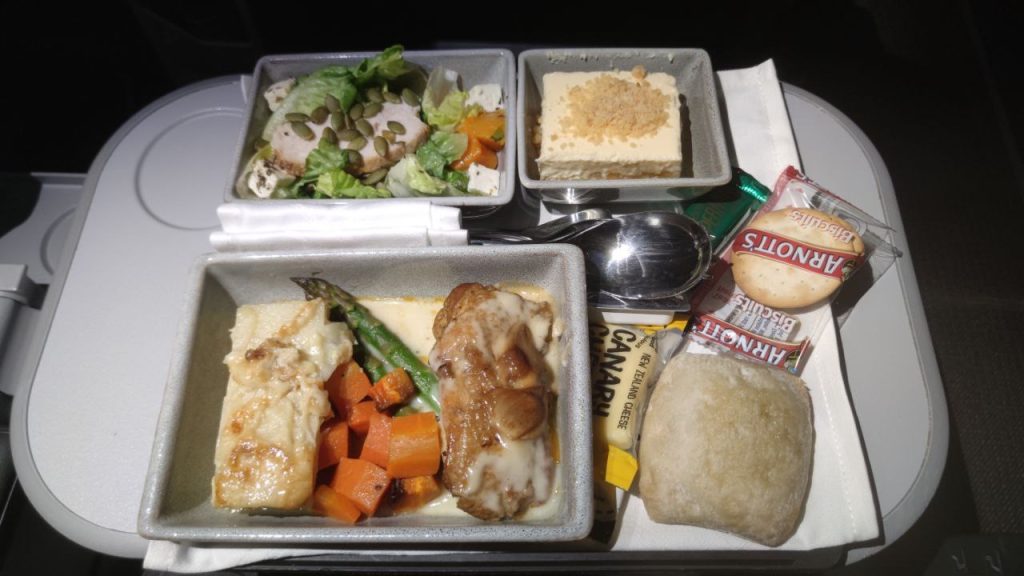
Throughout the flight, there were various snacks available, ranging from cereal bars, peas and crackers, muffins, KitKats and even Instant Noodles. After the lunch service, the crew quickly set up a cart in the galley, where passengers could go and grab the snacks which they desired.
Instant Noodles were available on demand. The crew were also proactive in walking through the galley, serving drinks and snacks when requested. I got a turkey sandwich, which was rather filling and was an unexpected addition as I expected only basic snacks to be available.
Approximately 2 hours before the flight landed in New York, we were served a warm Mushroom Pizza as a pre-landing snack. Given that we were about to land in New York at evening time, this snack was appropriate to be served at this hour. Not long after, we soon started our descent into New York’s John F Kennedy International Airport.
About an hour and a half before landing, we were served a pre-landing snack of a Pizza. Well, it was definitely not the best pizza I had, but definitely not the worst. I’ll leave it for you to judge the pizza 🙂
Soon, our time on the World’s longest flight came to an end, as we made our approach towards New York. Our flight path brought us on a rather scenic view of New York City. What an amazing way to start my vacation in New York!
In flight entertainment
The inflight entertainment has a sufficient amount of movies and TV shows, definitely sufficient to keep you entertained for the entire 18 hours of the flight. The screen was also rather responsive, and the brightness of the screen could also be modified according to personal preference. The screens were a staggering 13.3 inch, and could also be controlled with a remote control. Furthermore, Noise Cancelling Headsets were offered by Singapore Airlines, for the passengers to use to watch their movies in flight. This is definitely an upgrade from what is offered in their Economy Class Cabins, where passengers would only have a wired earpiece.
Singapore Airlines offers an extensive Inflight entertainment selection, with the latest movies and television shows which are offered onboard. Furthermore, the airline also offers free inflight WiFi to its customers who are Krisflyer members, the loyalty program of Singapore Airlines. This made the ultra-long haul journey rather bearable as passengers were now able to utilise the internet to access their emails, or even use their social media applications to stay in contact with their loved ones. For me, as an Avgeek, I used the Inflight WiFi to do some self-tracking on the FlightRadar24 application.
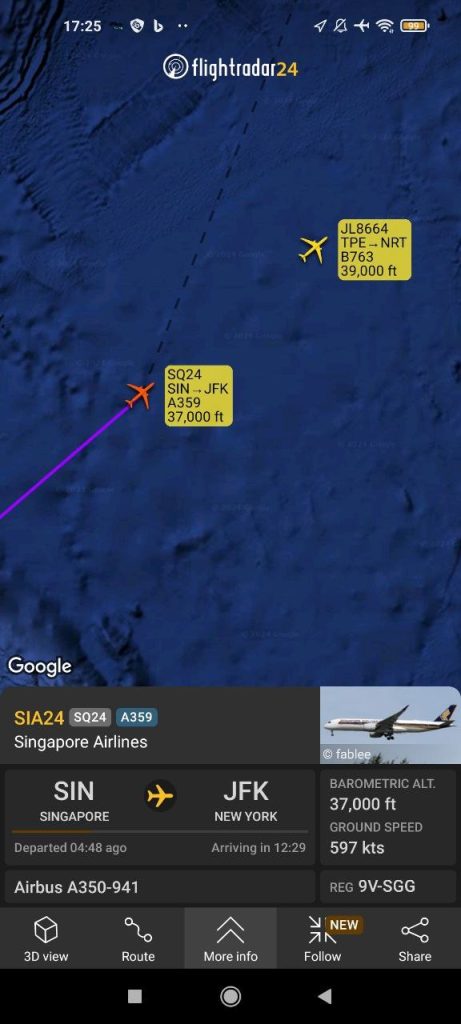
One good feature of the flight was definitely the access to the in-flight map, together with a birds eye view of the places we were flying over. Singapore Airlines has this unique feature in their in-flight map, where we are able to see the ‘Heads Up Display’ from the comfort of our own screens. Furthermore, the Heads Up Display contains information about our flight, such as the Altitude and Airspeed.
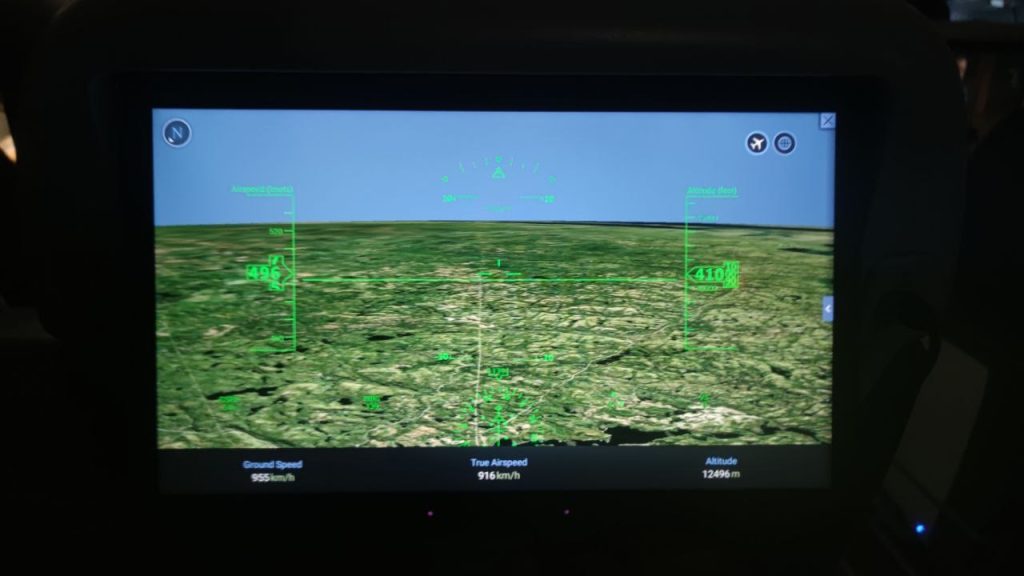
Cabin Service
The immaculate cabin service would definitely be deserving of a shoutout from me — The crews were highly attentive and took initiative in offering passengers drinks. Multiple times through the flight, the crews could be seen walking down the aisle with a tray of water, apple and orange juice, offering it to any passengers who requested it. Furthermore, the crews were highly professional and warm, greeting each passenger by their surnames and even taking time to confirm the pre-booked orders with the passengers.
And with that, the time passed in a blink of an eye on the world’s longest flight. This flight certainly felt way quicker than some of the medium/long haul flights which I flew before. Would I do it again? Definitely!


